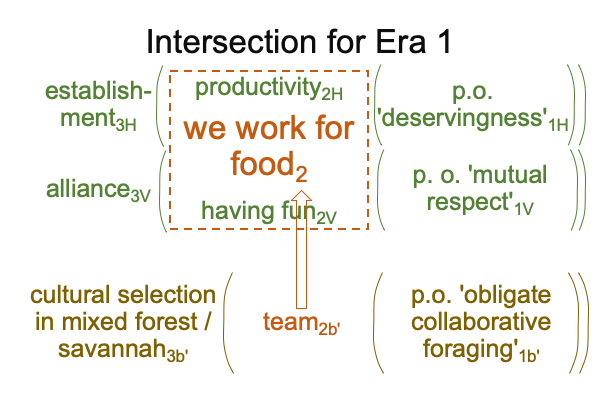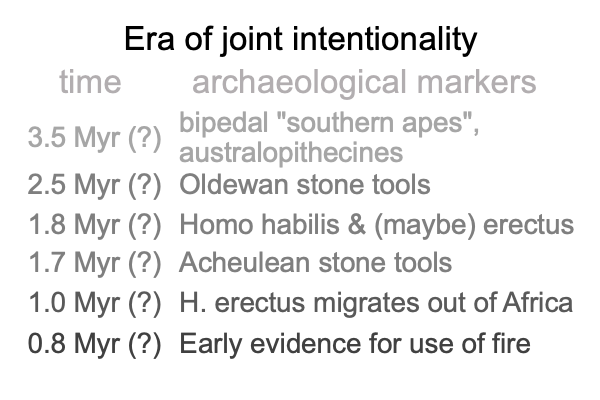0462 If an evolutionary anthropologist from today could go back in time to Homo habilis, she would be shocked at the things that our ancestors ate. Homo habilis and its next of kin, Homo erectus, are on the lookout for any food that other species ignore or cannot get to. They compete with giraffes, who specialize in getting food that is high up, and zebras, who specialize in getting food growing out of the ground. They also compete with baboons, hyenas, large cats and other dangerous critters.
So, where is hominin food supposed to come from?
0463 Neither giraffe, zebra, hyena or baboon can find food that is not edible, but becomes edible after being hidden. Decay is like digestion. Bugs can do the work, if the bugs are themselves edible. So can fungus.
In mixed forest and savannah, food is always abundant, at the right location and not for long. So, mixed forest and savannah selects for teams that forage when the time is right. In addition, many teams figure out how to store… er… hide food after sharing with other teams in the band. How is today’s evolutionary anthropologist supposed to figure out the diverse ways of obtaining, preparing, sharing and hiding food?
Even more incredibly, over generations, each successful team gets better and better at whatever they figured out, because a successful team leads to one’s genes getting into the next generation. Neuronal tracts sensitive to whatever a successful team figures out are laid down in order to make team actions more and more intuitively natural, innate, and more likely to be spontaneously discovered under novel environmental and ecological conditions.
0464 Yes, today, if we even glanced at a menu composed of what these folks ate, we would immediately barf.
0465 Fortunately, Tomasello’s topic is morality, rather than culinary magic.
Tomasello sees team joint-activities as supporting an inclination to help one another.
Is this the first expression of what we call, “sympathy”?
He relates this expression to three sets of psychological processes, (1) a network of “you-me” relations, (2) partner choice and control and (3) self-regulation. The first (1) constitutes the “we” of the team. A team is not simply 15 “me”s. A team is composed of over 100 “you-me” relations. The second (2) claims that deservingness1H and mutual respect1V are crucial for a coherent team. The third (3) suggests that everyone innately knows (1) and (2). Indeed, all three psychological processes are observed in the cognitive development of newborns and infants.
0466 In teams, power2H entails productivity2H.
Affiliation2V goes with having fun2V.
The team has a slogan, declaring, “We work for food.”
But, hand-talk cannot explicitly abstract the word, “work”. So, maybe the word, “do”, will suffice. We do food? Okay, I am sticking with the first team slogan.
0467 Here is a picture.

Note how the intersection maintains continuity. The normal contexts remain the same.
Note how the constituting actualities and their associated potentials change.
Cultural selection3b favoring obligate collaborative forgaging1b alters the character of the intersection2b, from power1Hand affiliation1V to productivity1H and having fun1V.
0468 We work for food2b is the primary actuality2b undergoing cultural selection3b for nearly three million years, from the start of bipedalism (around 3.5Myr) to the start of the domestication of fire (0.8My). The Homo genus, the intention of humans, is conceived and born in the era of joint intentionality.
0469 Here is a list of significant archaeological markers for this era.

0470 In the subsection titled, “Collaboration and Helping”, Tomasello calls the emergence of the Homo genus, “self-domestication”.
Self-domestication weaves three strands into one rope.
First, human pair-bonding is recognized as productive, thereby formalizing the role of father (and assuring his paternity of his mate’s children). The slogan, “We work for food.”, extends to “We work for one another in the family.”
Second, new subsistence strategies evolve. The Oldowan and Acheulean stone tools serve as an example. Oldowan stone tools are made rapidly and on location. Acheulean stone tools require preparation. They are made at one location then carried to another. The Oldowan and the Acheulean stone-tool teams are one among many. Successful teams become better and better over generations as the neural architecture that supports the relevant behavioral skills and cognitive capacities evolves.
Third, cooperative childcare becomes a style of teamwork, in addition to collaborative foraging. Childcare teamworkbroadens the nature of “you-me” relationships into new arenas of joint attention. Shared intentionality becomes more and more…what is a good word for it?… ah… “domestic”.
0471 Tomasello envisions these three strands weaving together into a metaphorical rope that tames hominins.
Hominins self-domesticate.
